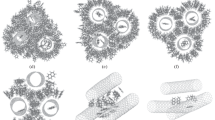Abstract
A theoretical estimation of the sorption capacity of hydrogen sponges, i.e., materials composed of nanotubes, in the absence of specific sorption centers at the inner surface of the tubes has been made. The estimate is based on the account for a relatively long-range van der Waals interaction between hydrogen and the sorbent material in the form of the Lennard-Jones potential. It is shown that tubes with a radius of R = 2.1–2.3 Å and smaller eject hydrogen molecules, while by R < 2.0–2.2 Å this barrier substantially exceeds kT, so that hydrogen practically does not penetrate into the tubes. This result has been confirmed experimentally. The tubes with larger radii, as the calculation shows, retract hydrogen. However, even by a maximum retraction of hydrogen molecules (by tube radii of 2.5–2.8 Å), in the absence of specific sorption centers at their inner surface, the sorption capability of the sponges (in recalculation into the sorbent mass) does not exceed half a percent. The presence of a periodic supramolecular relief (corrugation) in the tubes, as a rule, results in a reduction of the sorption capability. Thus, the search for and creation of hydrogen sponges in the class of such supramolecular structures are not topical.
Similar content being viewed by others
References
J. W. Steed and J. L. Atwood, Supramolecular Chemistry (Wiley, 2000).
R. G. Kostyanovsky, P. A. Levkin, K. A. Lyssenko, et al., Mendeleev Commun. 12 (6), 220 (2002).
M. Jordá-Beneyto, F. Suárez-García, D. Lozano-Castelló, and D. Cazorla-Amorós, Carbon 45 (2), 293 (2007).
S. Satyapal, C. Readl, G. Ordaz, N. Stetson, G. Thomas, and J. Petrovic, “U.S. DOE Hydrogen Program,” in Proc. 4th U.S.-Korea Forum on Nanotechnology: Sustainable Energy (Honolulu, HI, Apr., 26–27, 2007).
J. Israelachvili, Intermolecular and Surface Forces (Acad. Press, London, 1991).
L. D. Landau and E. M. Lifshits, Quantum Mechanics (Nauka, Moscow, 1974) [in Russian].
H. Tatemitsu, F. Ogura, Y. Nakagawa, N. Nakagawa, K. Naemura, and M. Nakazaki, Bull. Chem. Soc. Jpn. 48 (9), 2473 (1975).
Nguyen Tuong Vi, “Molecular interactions and chirality,” Ph.D Thesis (Faculty of Science, UNSW, Sydney, 2005).
S. V. Stovbun, A. M. Zanin, A. A. Skoblin, et al., Dokl. Akad. Nauk 446 (5), 645 (2012).
Author information
Authors and Affiliations
Corresponding author
Rights and permissions
About this article
Cite this article
Stovbun, S.V., Skoblin, A.A., Kostyanovsky, R.G. et al. Estimation of the sorption ability of supramolecular hydrogen sponges. Nanotechnol Russia 10, 235–241 (2015). https://doi.org/10.1134/S1995078015020172
Received:
Accepted:
Published:
Issue Date:
DOI: https://doi.org/10.1134/S1995078015020172




